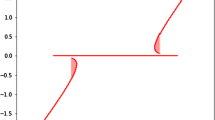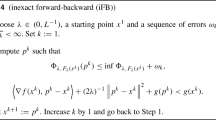Abstract
We consider the optimization problem
which is an extension of a problem studied by Idrissi, Lefebvre and Michelot [7]. This class of problems contains many practically important special cases so as approximation, location and optimal control problems, perturbed linear programming problems and surrogate problems for linear programming. Necessary and sufficient optimality conditions are derived using the sub-differential calculus. A proximal point algorithm is modified by the method of partial inverse [13] in order to solve the optimality conditions.
Similar content being viewed by others
References
Benker H (1985) Upper and lower bounds for minimal norm problems under linear constraints. Banach Center Publications Warsaw 14:35–45
Cooper L, Katz IN (1981) The Weber problem revisited. Computers and Mathematics with Applications 7:225–234
Durier R (1984) On efficient points and Fermat-Weber problem. Working Paper, Universite de Bourgogne, Dijon, France
Durier R, Michelot C (1985) Geometrical properties of the Fermat-Weber problem. European Journal of Operational Research 20:332–343
Francis RL, White JA (1974) Facility layout and location: An analytical approach. Prentice-Hall, Englewood Cliffs, NJ
Göpfert A (1973) Mathematische Optimierung in Allgemeinen Vektorräumen. BSB BG Teubner Verlagsgesellschaft, Leipzig
Idrissi H, Lefebvre O, Michelot C (1988) A primal-dual algorithm for a constrained Fermat-Weber problem involving mixed norms. Recherche operationnelle/Operations Research 22 (4): 313–330
Jahn J (1983) Zur vektoriellen linearen Tschebyscheff — Approximation. Math Operations-forsch Statist Ser Optim 14:577–591
Jahn J (1986) Mathematical vector optimization in partially ordered spaces. Lang Verlag Frankfurt, Bern, New York
Kuhn HW (1973) A note on Fermat's problem. Mathematical Programming 4:98–107
Michelot C, Lefebvre O (1987) A primal-dual algorithm for the Fermat-Weber problem involving mixed gauges. Mathematical Programming 39:319–335
Rockafellar RT (1976) Monotone operators and the proximal point algorithm. SIAM J Contr Optim 14:877–898
Spingarn JE (1983) Partial inverse of a monontone operator. Applied Mathematics and Optimization 10:247–265
Spingarn JE (1985) Applications of the method of partial inverses to convex programming: decomposition. Mathematical Programming 32:199–223
Tammer C, Tammer K (1991) Generalization and sharpening of some duality relations for a class of vector optimization problems. ZOR — Methods and Models of Operations Research 35:249–265
Tammer C (1993) Necessary conditions for approximately efficient solutions of vector approximation problems. Proceedings of the 2nd Conference on Approximation and Optimization, Havana (to appear)
Weiszfeld E (1937) Sur le point pour lequel la somme des distances de n points donnes est minimum. The Tohoku Mathematical Journal 43:355–386
Wendell RE, Peterson EL (1984) A dual approach for obtaining lower bounds to the Weber problem. Journ of Regional Science 24:219–228
Witzgall C (1964) Optimal location of a central facility: Mathematical models and concepts. National Bureau of Standards, Report 8388, Washington
Zeidler E (1978) Vorlesungen über nichtlineare Funktionalanalysis III — Variationsmethoden und Optimierung. Teubner Verlagsgesellschaft, Leipzig
Author information
Authors and Affiliations
Rights and permissions
About this article
Cite this article
Benker, H., Hamel, A. & Tammer, C. A proximal point algorithm for control approximation problems. Mathematical Methods of Operations Research 43, 261–280 (1996). https://doi.org/10.1007/BF01194548
Received:
Revised:
Issue Date:
DOI: https://doi.org/10.1007/BF01194548




